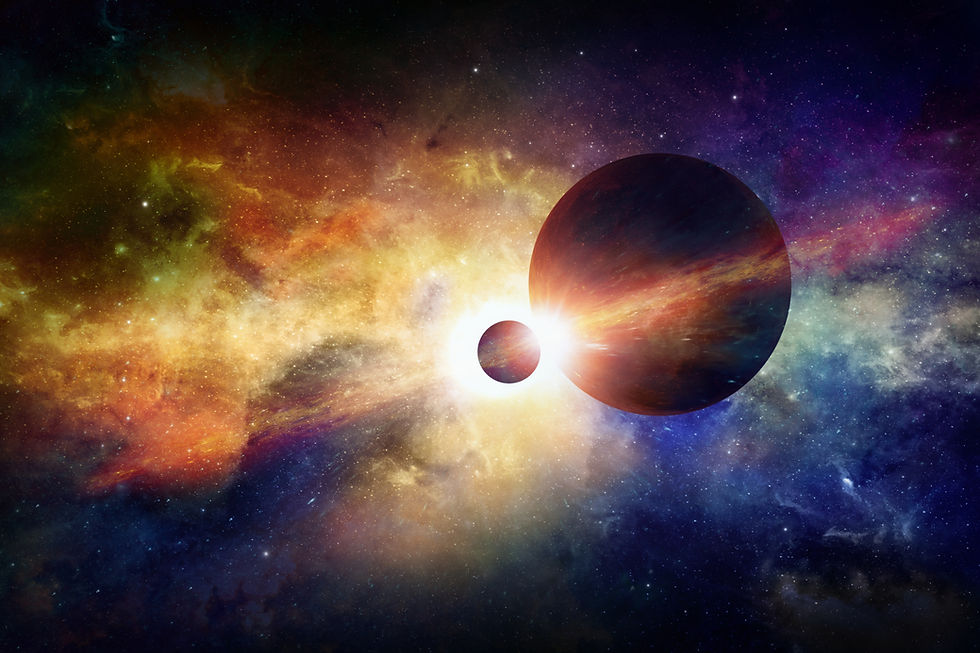Static Electricity on Earth & in Space
- Sylvia Rose

- Apr 17
- 4 min read
Static electricity happens due an imbalance of electric charges powered by the movement of electrons. They orbit the nucleus of an atom, and in some situations jump from one atom to another.

Everything is made of atoms. In the nucleus of an atom are positively charged protons and neutral neutrons. Negatively charged electrons are held in orbit by attraction to the positive protons.
While the charges are usually balanced, electrons can sometimes transfer from one object to another. When an object gains electrons, it becomes negatively charged.
Conversely, when it loses electrons, it becomes positively charged. These opposite charges attract each other, leading to the familiar phenomena associated with static electricity.

Static Electricity on Earth
Carpets & Doorknobs
Walking across a carpet causes friction, transferring electrons from the carpet to the person's shoes. This creates an excess of negative charge in the body.
When the person touches a grounded object, like a metal doorknob, the excess electrons rapidly discharge, causing the shock and perhaps a visible spark.
A dry environment, especially in winter, exacerbates this. Dry air is a poor conductor, preventing the charge from dissipating easily.

Lightning
A dramatic example of static electricity, lightning is a massive discharge between clouds, or a cloud and the ground. Collisions of ice crystals and water droplets create an accumulation of static charge in thunderclouds,
The buildup of force creates an electric field. When the charge is strong enough to overcome insulating properties of air, it discharges as a surge of ions, electrons and electromagnetic radiation, a bolt of lightning.
A single bolt of lightning averages about 30,000 amperes. Temperature can reach 16,650°C (30,000°F), hotter than the surface of the sun.

Clingy Clothes
Synthetic fabrics, like polyester, are prone to building up static charge. Thus clothes fresh out of the dryer often cling to each other or a person's body. Dryer sheets contain chemicals to neutralize the static charge.
Electrophotography
Photocopiers and laser printers apply the principles of static electricity to attract toner particles to paper, creating sharp high-quality images.
Defibrillators
Defibrillators use static electricity to deliver controlled electric shocks to the heart, in hopes of restoring its normal rhythm.
Atmospheric Events
Static electricity contributes to spectacular phenomena like auroras. These happen when charged particles from the sun collide with Earth's magnetic field, producing brilliant displays of light.

Food
Static electricity can affect the flavor of certain foods. Crumbling potato chips in their bag generates static electricity. Surfaces attract fine particles and alter the perceived texture and taste.
Static Electricity in Space
In the vacuum of space, static electricity is even more influential.
Dust and Planetary Formation
In protoplanetary disks, the swirling clouds of gas and dust surrounding young stars, static electricity causes clumping of dust grains. Charged through contact and friction, many grains attract each other.
Static-electric interactions in space causes dust to either clump together or repulse. Attracted grains form larger aggregates and eventually planets.

NASA's Mars rovers, like the long-lived Curiosity, have had problems due to static electricity. Accumulated dust on solar panels is a concern. China's Zhurong Rover failed to wake up from hibernation in 2022 due to dust.
Spacecraft Charging
Spacecraft orbiting Earth are bombarded by charged particles from the solar wind. The craft accumulate a static charge. If it gets too big, it can discharge through electronic components. Engineers design spacecraft with conductive materials and grounding systems to mitigate the risk.
Lunar Dust Levitations
The Moon, lacking a substantial atmosphere, is constantly exposed to solar radiation, giving a positive charge to the lunar surface. Dust particles on the Moon also become charged.

In electrostatic repulsion dust levitates from the surface. The striking effect has been observed by astronauts. It's a problem for lunar missions, as the fine, abrasive dust can degrade equipment and visibility.
Rings of Saturn
Saturn's rings are made of countless icy particles. The particles become charged through collisions and exposure to radiation. Electrostatic forces help shape the structure and dynamics of the rings.
Charged Moons
Both Enceladus (Saturn) and Jupiter's moon Io display variations in electric charge due to their interactions with surrounding space plasma. Charged particles emitted by the icy plumes of Enceladus interact with Saturn's magnetosphere.
The particles are mainly water vapor and dust, which are then ionized and become part of Saturn's magnetospheric plasma. The plasma affects the formation of the E ring, the planet's magnetic field and auroras.

READ: Lora Ley Adventures - Germanic Mythology Fiction Series
READ: Reiker For Hire - Victorian Detective Murder Mysteries


